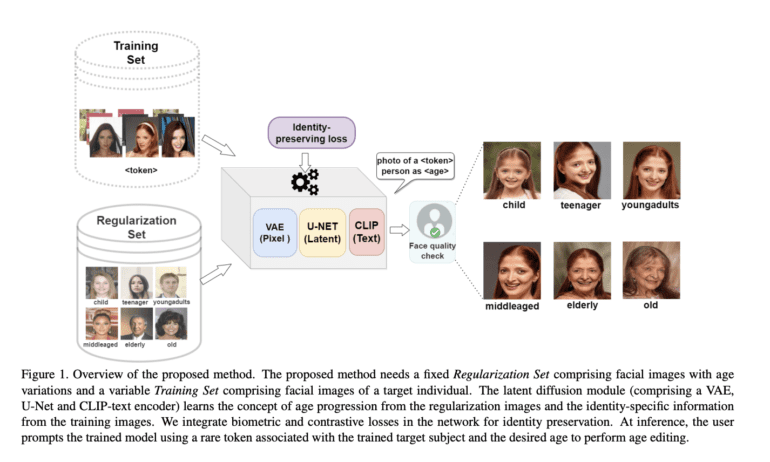TL;DR:
- NYU Tandon School of Engineering introduces a breakthrough AI technique for altering facial age while maintaining a unique biometric identity.
- Approach involves training AI on individual images and annotated age categories, enabling precise age transformation.
- Text prompts guide AI to achieve desired age outcomes through controlled neural network transformations.
- Model leverages pre-trained latent diffusion mode, a concise set of facial images, and image-caption pairs for age understanding.
- The method surpasses alternative techniques in accuracy, reducing incorrect rejections by up to 44%.
- Training dataset composition influences AI’s ability to portray diverse age ranges and genders.
- Ethnical and racial variations do not significantly impact AI’s generated outcomes.
Main AI News:
The realm of artificial intelligence is witnessing a groundbreaking advancement as researchers at NYU Tandon School of Engineering introduce a revolutionary technique that elegantly reshapes an individual’s apparent age in images without compromising their unique biometric identity. In a landscape where AI is increasingly deployed to meticulously gauge and manipulate age attributes through image analysis, this innovation opens doors to a myriad of possibilities.
The crux of this achievement lies in the adept fusion of cutting-edge AI methodologies with the reservoir of human age-related data. The scientific community has long grappled with the challenge of crafting models that seamlessly transcend the aging continuum while safeguarding the core essence of facial individuality. This pursuit mandates an expansive dataset that chronicles the visages of countless individuals over an expanse of years – an endeavor demanding vast resources and time.
However, NYU’s researchers have traversed this terrain with finesse. Their modus operandi involves training an AI model on a modest assemblage of images for each subject. Concomitantly, a distinct compendium of images annotated with age categories – encompassing child, teenager, young adult, middle-aged, elderly, and old stages of life – acts as the lodestar. This amalgamation of chronological snapshots and textual cues furnishes the model with a comprehensive lexicon of age-related features.
The outcome is an AI that not only comprehends the nuances of aging but also discerns the intricate interplay between an individual’s countenance and the passage of time. The driving force behind this transformative prowess lies in the innovative utilization of text prompts. Armed with the capacity to specify the desired age outcome, the AI orchestrates the metamorphosis with uncanny precision, invoking a symphony of neural network components to weave a gradual, controlled transformation.
The model’s prowess owes its refinement to a multifaceted strategy. Leveraging a pre-trained latent diffusion mode, fortified by a concise yet informative set of 20 facial images per subject, grants the AI a profound grasp of identity-specific traits. Concurrently, a supplementary assemblage of 600 image-caption pairs elucidates the intricate dance between image and age, enabling the AI to navigate the tapestry of aging dynamics.
Refinement is the heartbeat of progress, and NYU’s team has left no stone unturned. With judiciously tailored loss functions, the model’s acumen is honed to a razor’s edge. The introduction and elimination of controlled image perturbations further elevate the AI’s prowess. Notably, the team introduces the “DreamBooth” technique, a symphony of neural components that orchestrates a harmonious fusion of human facial image manipulation, rendering the process not just precise, but aesthetically astute.
Validation comes through rigorous evaluation. Volunteer participants, numbering 26, were entrusted with the task of matching AI-generated images to their real-life photographic counterparts. This assessment was expanded to incorporate ArcFace, a distinguished facial recognition algorithm. The results reverberated with the model’s superiority, boasting a staggering reduction of up to 44% in erroneous rejections.
The team’s meticulous investigation uncovered intriguing dynamics. The composition of the training dataset plays a pivotal role. A dataset enriched with middle-aged images begets remarkable diversity across the age spectrum. However, a preponderance of elderly images triggers challenges in portraying polar opposites, such as children. Moreover, a gender dichotomy surfaces; the AI exhibits a remarkable affinity for transmuting images of men into older age brackets, potentially attributed to nuances like makeup in training images.
Notably, the AI’s artistic interpretation remains unbiased by ethnicity or race. Such variations, intriguingly, bestow no discernible imprints upon the generated tapestry.
Conclusion:
This revolutionary AI technique, developed by NYU Tandon School of Engineering, marks a significant stride in the realm of facial age alteration while safeguarding personal identity traits. By seamlessly incorporating image data and textual cues, the AI method adeptly transforms individuals’ apparent ages with precision. As this innovation outperforms existing methods and remains impartial to ethnicity and race, it opens new avenues for the market, promising transformative solutions in age modification and identity preservation.

